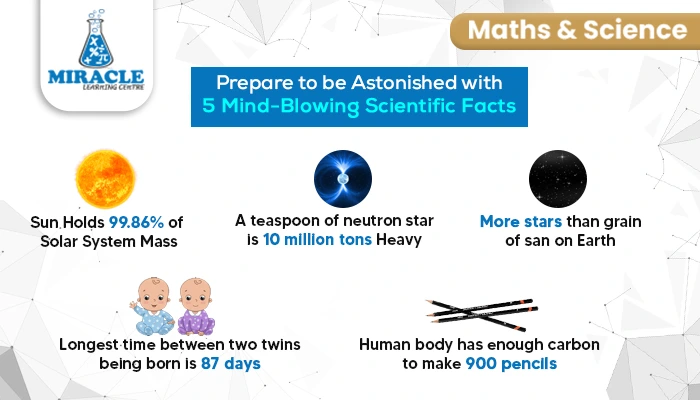Science is full of wonders and mysteries that never cease to amaze us. From the smallest atoms to the vast universe, there are countless fascinating facts that reveal the beauty and complexity of nature. At our science tuition centre in Singapore, we believe in nurturing that curiosity and fostering a deep appreciation for the wonders of the universe. In this blog, we will explore 5 amazing science facts that will blow your mind. Let’s get started!
1. The Sun is so massive that it accounts for 99.86% of the mass of the solar system
The Sun is the largest and most massive object in our solar system. It has a diameter of about 1.4 million kilometers, which is about 109 times the diameter of the Earth. It has a mass of about 1.989 x 10^30 kilograms, which is about 333,000 times the mass of the Earth. That means the Sun accounts for 99.86% of the mass of the entire solar system, leaving only 0.14% for all the planets, moons, asteroids, comets, and other objects. The Sun is so massive that its gravity holds the solar system together and determines the orbits of all the planets.
2. A teaspoon of neutron star would weigh about 10 million tons
A neutron star is the remnant of a massive star that has collapsed under its own gravity after a supernova explosion. It is one of the densest and most extreme objects in the universe. A neutron star has a radius of about 10 kilometers, but a mass of about 1.4 times the mass of the Sun. That means a neutron star has a density of about 10^17 kilograms per cubic meter, which is about a billion times the density of water. A teaspoon of neutron star material would weigh about 10 million tons, which is about the same as the weight of Mount Everest.
3. There are more stars in the observable universe than grains of sand on all the beaches on Earth
The observable universe is the part of the universe that we can see with our current technology. It has a radius of about 46 billion light-years, which is the distance that light has traveled since the Big Bang. According to some estimates, there are about 10^22 to 10^24 stars in the observable universe, which is a huge number that is hard to comprehend. To put it in perspective, there are about 10^18 grains of sand on all the beaches on Earth, which is also a huge number, but much smaller than the number of stars. That means there are more stars in the observable universe than grains of sand on all the beaches on Earth, by several orders of magnitude.
4. The human body contains enough carbon to make 900 pencils
The human body is composed of various elements, such as oxygen, hydrogen, carbon, nitrogen, calcium, and phosphorus. Carbon is one of the most abundant elements in the human body, accounting for about 18% of the body mass. Carbon is also the main element in graphite, which is the material used to make pencils. A typical pencil contains about 0.7 grams of graphite, which is about 0.3 grams of carbon. That means the human body contains enough carbon to make about 900 pencils, which is enough to write for a long time.
5. The longest time between two twins being born is 87 days
Twins are two offspring that are born from the same pregnancy. Usually, twins are born within minutes or hours of each other, but sometimes, there can be a significant gap between their births. The longest time between two twins being born is 87 days, which is almost three months. This happened in 2012, when Amy Elliott gave birth to her son Liam prematurely at 23 weeks, while his twin brother Ronan stayed in the womb until he was born at 36 weeks. Both twins survived and are healthy. This is a rare and remarkable case of delayed interval delivery, which occurs when the cervix closes after the first birth and prevents the second birth from happening until later.
So there you have it—science is like a treasure hunt full of mind-blowing surprises! Our science tutors are here to make sure you don't miss out on the fun. Join us at the science tuition centre in Singapore, where learning about the incredible world of science is anything but boring. Get ready to be amazed, and let's explore the awesome wonders of the universe together!








